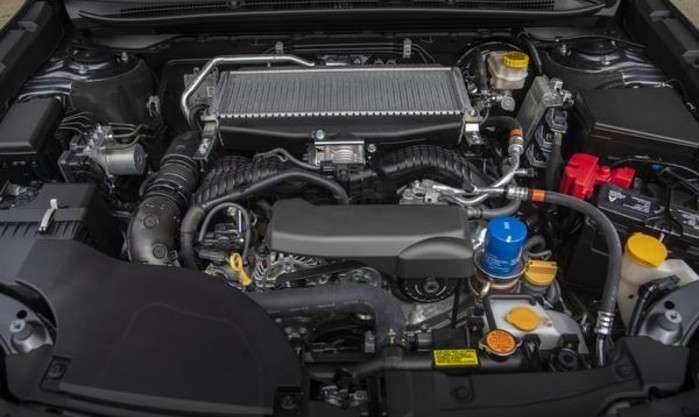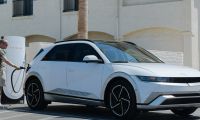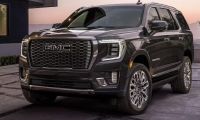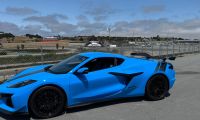If you want Subaru’s best engine they’ve ever designed, you can get it in the 2020 Outback, Ascent, and Legacy models. Subaru put the new smaller 2.4-liter turbocharged engine in the Ascent family hauler first, the biggest vehicle they’ve ever made. It was a good move because the new FA24 (which is the engine code that Subaru uses to identify its Boxer engines) has what you want, more power and improved fuel mileage.
When Subaru discontinued the 3.6-liter in the Outback, they needed an engine that would bring power, fuel efficiency, and be reliable for customers. Subaru engineers succeeded in a big way and it’s why it will be the brand’s engine of the future. We want to give a shout out to Donut Media, where the technical information for this article came from.

Customers want an engine that's going to be reliable and not be in the shop for repairs. How did the Japanese automaker squeeze so much power out of the smaller engine without blowing it up?
One of the biggest improvements in the new FA24 2.4-liter turbocharged powerplant is the addition of direct fuel injection as opposed to the older version port injection in the 3.6R. Port injection places the fuel injector in the intake manifold upstream from the intake valve. The air and fuel mix together before entering the combustion chamber and it’s less efficient.
Direct injection shoots the fuel directly into the cylinder delivering a much more precise air/fuel mixture and improves efficiency. It increases the pressure and thus horsepower, and also lowers the temperature in the cylinder, lowering the chance of pre-ignition.
Subaru also improved the cylinder head giving the air a straighter shot into the cylinder by taking out the bends. This takes out turbulence and improves the air flow at higher revs. More air plus more fuel from the direct injection equals more power.

But Subaru had to beef up the engine block and internals to handle the increase in horsepower. In a turbocharged engine it’s even more critical because of the extra boost from the turbocharger. Subaru increased the thickness of the cylinder walls, and added larger connecting rods, which are twice as thick as the EJ25 turbocharged engine in the WRX STI.
Subaru also needed to upgrade the valve springs. The FA24 comes with new ”Beehive” valve springs that are smaller at the top and wider in the middle, making them stronger and can handle more pressure and higher revs (500-700) than a normal spring.
All the added upgrades in the new FA24 2.4-liter turbocharged engine enabled Subaru to put it in the Ascent 3-Row SUV, the largest vehicle they ever built, and deliver more power and torque than the competitors V6 engines. It’s fuel efficient, and it will be a reliable engine for customers.
The new 2.4-liter turbo four-cylinder Boxer powering the Outback XT, and Ascent produces 260 horsepower and 277 lb-ft of torque and gets an EPA estimated 23/30 city/highway mpg and 26 combined mpg. The Outback Outdoor XT also has a towing capacity of 3500 lbs, up from the previous 2700 lb. limit, and Ascent has a 5,000 lb tow rating. Check out the complete 3.6R six-cylinder vs 2.4-liter turbocharged engine comparison below.
The new FA24 2.4-liter turbocharged engine in the 2020 Subaru Outback, Ascent and Legacy is the Japanese automaker’s best Boxer engine yet and they plan on using it in more models. Look for it in the next-generation 2022 WRX STI and 2021 BRZ sports cars.
You Might Also Like: New Subaru Outback XT 2.4L Turbo Vs. Discontinued 3.6L Engine
Denis Flierl has invested over 30 years in the automotive industry in a consulting role working with every major car brand. He is an accredited member of the Rocky Mountain Automotive Press and the founder of Subaru Report where he covers all of the Japanese automaker's models. More stories can be found on the Torque News Subaru page. Follow Denis on Facebook, Twitter, and Instagram.
Subaru Report - We’ve got you covered! Check back tomorrow for more unique, informative SUBARU news, reviews, and previews you can trust.
Leave your comments below, share the article with friends and tweet it out to your followers!
Photo credit: Subaru USA













Comments
Re. reliability of BMW and
Permalink
In reply to Horizontally opposed engine by pj (not verified)
Re. reliability of BMW and Toyota I couldn’t agree more...
I had a lease of a BMW 530 D biturbo and it was powerful enough. And most reliable for the 3 years of our contract.
The power curve was always going up while pressing the accelerator...until the motor cut off past 7,000 rpms
Only 6 cylinders and 2 turbos...with diesel. What a beast !
Now I drive a Forester 2.5 Limited and is good...but not the same power although I don’t need more with 55/65 mph speed limits...
Speaking about the
Permalink
Speaking about the reliability of an engine that launched a year ago is stupid.. We need to wait a few years to know for sure.
@George B. that is certainly
Permalink
@George B. that is certainly not true whatsoever. If you add a turbo to an engine designed without one, then you are adding more stress than the block, pistons, piston rings, etc. we're designed for.
But an engine that is designed to have a turbo is completely different. For example, how many Cummins turbo-deisel engine have 1,000,000 miles on them? Diesel designs already put more stress on the components than gasoline designs. But how can they add a turbo and not blow it up?
Because the manufacture used parts that are designed to withstand the pressure, that's why.
Wow! Someone with common
Permalink
In reply to @George B. that is certainly by Simon (not verified)
Wow! Someone with common sense. If an engine is designed to be a turbo engine it has to be beefier out of the gate. I do agree that without data you can not say an engine is great or the bomb diggity of all time. Unfortunately this kind of data is only obtained through actual consumer use. Using a test facility and dyno's are not real world application. Let's hope that Subaru is headed in the right direction.
The greatest contribution to
Permalink
The greatest contribution to reliability Subaru could make would be to integrate the heads into the cylinder assemblies thus removing the troublesome head gasket at the root of so many problems.
This has been done before. The head and cylinder assembly simply bolt onto the crankcase and thus have an unpressurized union to the engine.
Cost would not be greater as they have to make a head and cylinder block anyway and then have very comprehensive bolt configuration to ensure a good seal on the current head gasket plus the attachment of the cylinder block to the crankcase.
Good idea but a reliable head
Permalink
In reply to The greatest contribution to by Mark (not verified)
Good idea but a reliable head gasket on a boxer engine is not rocket science - BMW and Porsche have been doing it for over half a century. Only Subaru's engineers could get it wrong, keep getting it wrong, try a new design and get it wrong again. They could have called BMW's or Porsche's parts department, said send us a head gasket, took it apart to to how it's done, and presto!
Yes, you are correct. They
Permalink
In reply to Good idea but a reliable head by Lee Taplinger (not verified)
Yes, you are correct. They could have just bought a used 911 turbo and taken it apart.
Huh? Subaru's engine was
Permalink
In reply to Yes, you are correct. They by Mark (not verified)
Huh? Subaru's engine was designed to include a turbo charger since before it was designed. They don't need another car or engine to steal parts from. Do you still not understand?
Edit: @Mark, I didn't follow
Permalink
In reply to Huh? Subaru's engine was by Simon (not verified)
Edit: @Mark, I didn't follow the order of comments correctly, disregard my last comment.
Are you kidding me?
Permalink
Are you kidding me?
With all the quality control problems Subaru has had in the last few consecutive years, I wouldn't even think of owning one. Far too many seemingly unsolvable issues and disgusting support from dealerships.
DId they get rid of the
Permalink
DId they get rid of the rodent attracting soy wiring?
Hmmm...I wonder why the
Permalink
Hmmm...I wonder why the latest Ecoboost engines from Ford as well as the D-4S Lexus/Toyota (and even BRZ) have port AND direct fuel injection systems? Intake valve carbon anyone? My WRX got pretty good fuel economy if I stayed out of boost, but dragging an Ascent around probably means some boost (though admittedly I haven't driven one to know...I didn't consider one when I bought because I wanted to see how the CVT held up dragging around a heavier vehicle).
I guess we will see the
Permalink
I guess we will see the solution to the problems of the Boxer engine when Subaru gives us its EV.
We have a '19 Subaru Outback
Permalink
We have a '19 Subaru Outback with the 3.6R. we just completed a 1000 road trip and averaged 33.3mpg at 75mph with the AC on during the trip down and 30.3mpg on the trip back. Outstanding mileage considering the 3.6 Outback was only rated for 26mpg highway. Very smooth and responsive engine.
Our family owns 2 outbacks...
Permalink
Our family owns 2 outbacks....a 2013 3.6R limited and a 2020 ouback xt.....Question .......this article talks about the new 4 cylinder turbo being Subaru's best engine yet....then why is it that the 2013 came with a standard manufacturers powertrain warranty of 100,000 miles while the 2020's standard powertrain warranty is only 60,000. Why should I have confidence in the subaru new engines when obviously corporate does not.
As the owner of both a 2018 3
Permalink
As the owner of both a 2018 3.6 Outback and a 2020 Ascent...
The 2.4 turbo is a gas hog. Worse mileage than the 3.6 at roughly the same power bit the 3.6 is a quieter and less screaming
Also the new universal platform doesn't drive well. The power steering is way too light with zero road grill and towing anything... Even way within specs is a white knuckle ride
The comments are almost as
Permalink
The comments are almost as good as the article , I think there's hope with the boxer engine but the way it's being utilised isn't optimal , low boost 9psi and mid boost 15psi are good for consistent throttle only , going of those power levels the ej205 seems to be older equivalent with 400cc less , hope they do actual have either a 2.6L or 2.8L coming in the sti or future
It might be the best in
Permalink
It might be the best in regards to performance, weight, power and technology but time only tells when it comes to reliability. My wife has a 2016 Legacy with the 2.5i, which was supposed to be a redesigned more reliable engine and that turned out to be false. At 30k miles, the engine was consuming about 5 qts between oil changes. By 50k miles, she was consuming massive amounts of oil to the point it had to be refilled constantly. Subaru told her it was normal without even testing. They finally conceded to an engine oil consumption test and determined that it was something faulty. While it was in the shop, Subaru finally issued a repair notice and recall. In short, they ended up rebuilding her entire engine, replacing the short block, head gaskets, cam levers and the whole nine. Now, her car has 89k miles on it and she just got it back from her second major repair; again cam lever and both head gaskets blown. She changes the oil on 4-5k mile intervals and does all recommended services. Subaru comped all the repairs so far, including a repair at 50k miles, when her infotainment system failed for a potential repair cost of $3k. I've never known anyone to have this many issues with a Subaru, but the past issues with the 2.5i seem to finally be fixed, after decades of changes. The 2.4 turbo engine is fairly new and had some major failures in it's past, so truely, only time will tell on reliability.
I have a 2021 Legacy Touring
Permalink
I have a 2021 Legacy Touring XT and my main gripe is uneven acceleration. I don't think it's the engine's fault. It's the combination of the CVT and programming. A number of reviewers have noticed it in the Outback and Legacy with the 2.4. Maybe some day a update will improve it.
My 2019 Outback 3.6R was a
Permalink
My 2019 Outback 3.6R was a smoother, quieter car than the 2022 Outback XT I now drive. The turbo lag, surge is present enough to be disturbing. road, engine, and wind noise are all louder in the 2022 XT.
The '19 gave 34.X mpg for the 17K miles I drove it untill it was destroyed by a drunk. The '22 XT yeilds about the same in the low 24mpg for the 8K miles I have had it. The '22 is 80% of the car at 20% more cost. We shall see about reliability.
cost of cytotec online Young…
Permalink
cost of cytotec online Young Mongrel Dogs Wearing a Imidacloprid Flumethrin Collar with a Long Lasting Efficacy in the Prevention of Vector Borne Pathogen Transmission
Pagination